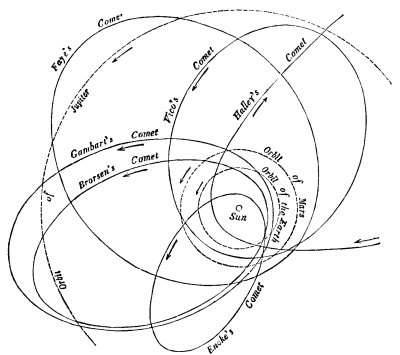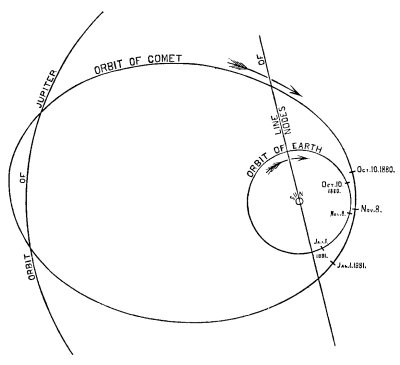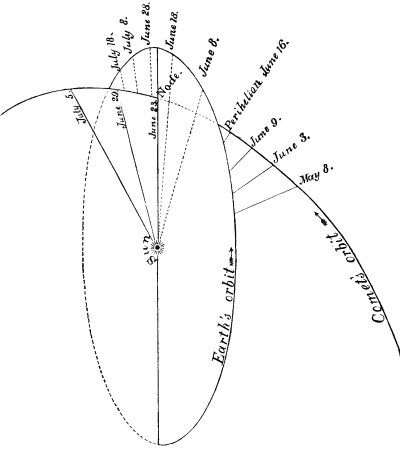
READER, the evidence I am about to present will satisfy you, not only that a comet might have struck the earth in the remote past, but, that the marvel is that the earth escapes collision for a single century, I had almost said for a single year.
How many comets do you suppose there are within the limits of the solar system (and remember that the solar system occupies but an insignificant portion of universal space)?
Half a dozen-fifty-a hundred-you will answer.
Let us put the astronomers on the witness-stand:
Kepler affirmed that "COMETS ARE SCATTERED THROUGH THE HEAVENS WITH AS MUCH PROFUSION AS FISHES IN THE OCEAN."
Think of that!
"Three or four telescopic comets are now entered upon astronomical records every year. Lalande had a list of seven hundred comets that had been observed in his time."
Arago estimated that the comets belonging to the solar system, within the orbit of Neptune, numbered seventeen million five hundred thousand!
Lambert regards five hundred millions as a very moderate estimate![1]
[1. Guillemin, "The Heavens," p. 251.]
{p. 83}
And this does not include the monstrous fiery wanderers who may come to visit us, bringing their relations

ORBITS OF THE PERIODIC COMETS.
along, from outside the solar system--a sort of celestial immigrants whom no anti-Chinese legislation can keep away.
Says Guillemin:
"Leaving mere re-appearances out of the question, new comets are constantly found to arrive from the depths of space, describing around the sun orbits which testify to the attractive power of that radiant body; and, for the
{p. 84}
most part, going away for centuries, to return again from afar after their immense revolutions."[1]
But do these comets come anywhere near the orbit of the earth?
Look at the map on the preceding page, from Amédée Guillemin's great work, "The Heavens," page 244, and you can answer the question for yourself.
Here you see the orbit of the earth overwhelmed in a complication of comet-orbits. The earth, here, is like a lost child in the midst of a forest full of wild beasts.
And this diagram represents the orbits of only six comets out of those seventeen millions or five hundred millions!
It is a celestial game of ten-pins, with the solar system for a bowling-alley, and the earth waiting for a ten-strike.
In 1832 the earth and Biela's comet, as I will show more particularly hereafter, were both making for the same spot, moving with celestial rapidity, but the comet reached the point of junction one month before the earth did; and, as the comet was not polite enough to wait for us to come up, this generation missed a revelation.
"In the year 1779 Lexell's comet approached so near to the earth that it would have increased the length of the sidereal year by three hours if its mass had been equal to the earth's."[2]
And this same comet did strike our fellow-planet, Jupiter.
[1. "The Heavens," p. 251.
2. "Edinburgh Review," October, 1874, p. 205.]
{p. 85}
In the years 1767 and 1779 Lexell's comet passed though the midst of Jupiter's satellites, and became entangled temporarily among them. But not one of the satellites altered its movements to the extent of a hair's breadth, or of a tenth of an instant."[1]
But it must be remembered that we had no glasses then, and have none now, that could tell us what were the effects of this visitation upon the surface of Jupiter or its moons. The comet might have covered Jupiter one hundred feet--yes, one hundred miles--thick with gravel and clay, and formed clouds of its seas five miles in thickness, without our knowing anything about it. Even our best telescopes can only perceive on the moon's surface--which is, comparatively speaking, but a few miles distant from us--objects of very great size, while Jupiter is sixteen hundred times farther away from us than the moon.
But it is known that Lexell's comet was very much demoralized by Jupiter. It first came within the influence of that planet in 1767; it lost its original orbit, and went bobbing around Jupiter until 1779, when it became entangled with Jupiter's moons, and then it lost its orbit again, and was whisked off into infinite space, never more, perhaps, to be seen by human eyes. Is it not reasonable to suppose that an event which thus demoralized the comet may have caused it to cast down a considerable part of its material on the face of Jupiter?
Encke's comet revolves around the sun in the short period of twelve hundred and five days, and, strange to say--
"The period of its revolution is constantly diminishing; so that, if this progressive diminution always follows the same rate, the time when the comet, continually
[1. "Edinburgh Review," October, 1874, p. 205.]
{p. 86}
describing a spiral, will be plunged into the incandescent mass of the sun can be calculated."[1]
The comet of 1874, first seen by Coggia, at Marseilles, and called by his name, came between the earth and the sun, and approached within sixty thousand miles of the flaming surface of the sun. It traveled through this fierce blaze at the rate of three hundred and sixty-six miles per second! Three hundred and sixty-six miles per second! When a railroad-train moves at the rate of a mile per minute, we regard it as extraordinary speed; but three hundred and sixty-six miles per second! The mind fails to grasp it.
When this comet was seen by Sir John Herschel, after it had made its grand sweep around the sun, it was not more than six times the breadth of the sun's face away from the sun. And it had come careering through infinite space with awful velocity to this close approximation to our great luminary.
And remember that these comets are no animalculæ. They are monsters that would reach from the sun to the earth. And when we say that they come so close to the sun as in the above instances, it means peril to the earth by direct contact; to say nothing of the results to our planet by the increased combustion of the run, and the increased heat on earth should one of them fall upon the sun. We have seen, in the last chapter, that the great comet of 1843 possessed a tail one hundred and fifty million miles long; that is, it would reach from the sun to the earth, and have over fifty million miles of tail to spare; and it swept this gigantic appendage around in two hours, describing the are of a circle six hundred million miles long!
[1. Guillemin, "The Heavens," p. 247.]
{p. 87}
The mind fails to grasp these figures. Solar space is hardly large enough for such gyrations.
And it must be remembered that this enormous creature actually grazed the surface of the sun.
And it is supposed that this monster of 1843, which was first seen in 1668, returned, and was seen in the southern hemisphere in 1880--that is to say, it came back in thirty-seven years instead of one hundred and seventy-five years. Whereupon Mr. Proctor remarked:
"If already the comet experiences such resistance in passing through the corona when at its nearest to the sun that its period undergoes a marked diminution, the effect must of necessity be increased at each return, and after only a few, possibly one or two, circuits, the comet will be absorbed by the sun."
On October 10, 1880, Lewis Swift, of Rochester, New York, discovered a comet which has proved to be of peculiar interest. From its first discovery it has presented no brilliancy of appearance, for, during its period of visibility, a telescope of considerable power was necessary to observe it. Since this comet, when in close proximity to the earth, was very faint indeed, its dimensions must be quite moderate.
The illustration on page 88 gives the orbit of the earth and the orbit of this comet, and shows how closely they approached each other; when at its nearest, the comet was only distant from the earth 0.13 of the distance of the earth from the sun.
It comes back in eleven years, or in 1891.
On the 22d of June, 1881, a comet of great brilliancy flashed suddenly into view. It was unexpected, and advanced with tremendous rapidity. The illustration on page 89 will show how its flight intersected the orbit of the earth. At its nearest point, June 19th, it was distant
{p. 88}
from the earth only 0.28 of the distance of the sun from the earth.
Now, it is to be remembered that great attention has been paid during the past few years to searching for comets, and some of the results are here given. As many as five were discovered during the year 1881. But not

a few of the greatest of these strange orbs require thousands of years to complete their orbits. The period of the comet of July, 1844, has been estimated at not less than one hundred thousand years!
Some of those that have flashed into sight recently have been comparatively small, and their contact with
{p. 89}

the earth might produce but trifling results. Others, again, are constructed on an extraordinary scale; but even the largest of these may be but children compared with the monsters that wander through space on orbits
{p. 90}
that penetrate the remotest regions of the solar system, and even beyond it.
When we consider the millions of comets around us, and when we remember how near some of these have come to us during the last few years, who will undertake to say that during the last thirty thousand, fifty thousand, or one hundred thousand years, one of these erratic luminaries, with blazing front and train of débris, may not have come in collision with the earth?
{p. 91}